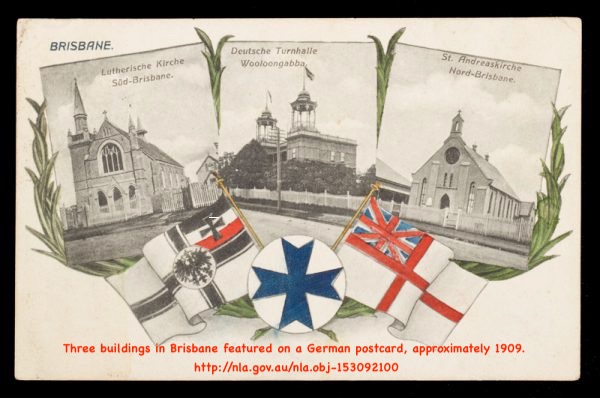Holy Trinity Anglican Church, 68 Hawthorne Street

As you drive along the freeway in the city direction have you wondered what the large white church seemingly at the top of a hill is? Is it Spanish? it looks Spanish to me. Maybe it’s Greek Orthodox and in such a prime position like that it must be Catholic. But no, that imposing building is the Holy Trinity Anglican Church, Woolloongabba.
The church in various guises has this year been there 150 years. The first, a simple wooden building, was built in 1869 but was blown down in a storm in 1874. The second, also timber, was burnt down in a fire in 1929. The present church was built in 1930 of brick with stucco finish in a Spanish Mission, Romanesque style. No wonder it’s so imposing.
Celebrating 150 years of Holy Trinity
The Holy Trinity Church is now celebrating 150 years, being one of the oldest churches in Brisbane. On Saturday night, 19th October as part of the sesquicentennial celebrations a celebratory cocktail party was held in the adjacent modern church hall – Trinity Place. I attended with my wife Christa and East Brisbane historian Geraint Gregory.

It was a lovely occasion with a great array of delicous food available for grazing, some rather interesting drinks, a string quartet accompaniment and a history display. The speeches were kept to a minimum with Father Ron the minister and Ian Lacey telling of the background and history and sharing personal experiences of the historic church.

The church itself was open and there was a wonderful display of wedding dresses of brides who had been married there dating as far back to one in 1942 (with the bride’s mother’s veil from 1907) to current times.
As well as the bridal gowns there were photos and other memorabilia. Beside a gown from 1966 were photos of that wedding and of one in 2000 of the couple’s son who was also married there. It is good to note that all couples remained married.
This spectacular display was put together by Ann Lacey who married Ian in 1984. It’s amazing how much effort was put into where the dresses on mannequins were placed.

One in front of the organ, another with stained glass windows as a background.

We were actually invited to take our drinks in to see the display. First time I’ve had a beer in a church. Here’s to you Ann!

Overall it was a wonderful festive occasion I’m sure enjoyed by all.
(text: John Gerard)
Nazareth Lutheran Church, 12 Hawthorne Street


The Nazareth Lutheran church has a very interesting history. It started out as a small wooden church for the German Lutheran community in 1861 and was known as the Lutherische Kirche, Süd -Brisbane (Lutheran Church, South Brisbane).
It was badly damaged during the 1893 floods and a new, bigger church was built on higher ground in its present location at 12 Hawthorne St, Woolloongabba with bricks and timber from a demolished hotel near Stanley Bridge. It was designed by prominent architect Charles McLay, who also designed the Post Office in Fortitude Valley and Customs House in Brisbane. In 1941, during WWII, the name was changed to the Nazareth Lutheran Church.
After an arson attack in May 2000, only the brick exterior walls remained but it was rebuilt as closely as possible to the original design and re-opened in 2001. Since then a church hall, a residential care centre and a child care centre have been added to the site. The church is now heritage listed on the Local Heritage Register.
St Nicholas Russian Orthodox Cathedral, 344 Vulture Street

This beautiful heritage-listed church represents the history of Russian migration to Brisbane. It is the first purpose-built Russian Orthodox Church in Australia.

The Russian Orthodox parish in Woolloongabba was established by white Russians fleeing the Russian revolution. Initially they worshipped in St Thomas’ Anglican Church in South Brisbane. In 1925 they purchased a cottage in Vulture Street and converted it into a church. In 1935 the old church was moved to the back of the block so that a new church could be built.
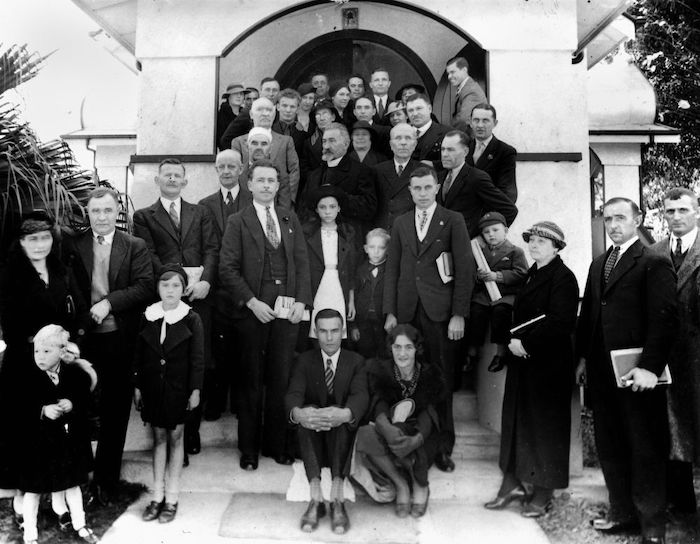
The new church was designed by Mr Gregory Mekhonoshin and given to a firm of Architects, Messrs. Cavanagh and Cavanagh, for final professional preparation. Construction started in 1935 and was completed in 1936. (Information taken from: Galina Zakrjevsky, History of St Nicholas Russian Orthodox Cathedral in Brisbane, Australia 1923-1993, 1997). Photo and text: SLQ


The thanksgiving luncheon celebrates the opening of the
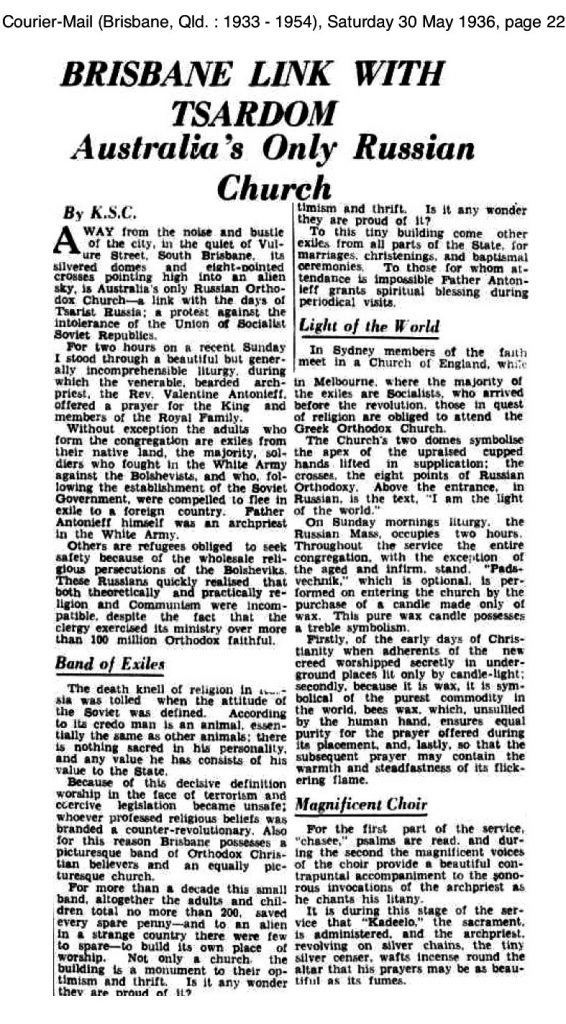 The founding Fathers of St Nicholas Cathedral
The founding Fathers of St Nicholas Cathedral
The founding fathers of the cathedral were Archpriests Father Alexander Shabasheff and Father Valentin Antonieff. Here’s an overview of their contribution.
- Father Alexander Shabasheff archpriest 1923 – 1929

Alexander Shabasheff (1881-1956) was born in Voronezh, Russia on 14 April 1881. He studied Theology, graduated in 1910 and then served in several local parishes. He joined the White Army during the Civil War of 1918 and served as a military priest. He was awarded the Order of St George for his bravery and received lifetime rights to wear a pectoral cross on the St. George ribbon. In 1920 he and his wife crossed the Chinese border and settled in Harbin where he worked as abbot in the monastery of the Beijing Spiritual Mission.
On 16 July 1923 he arrived in Australia and lived in Brisbane. He worked as a storekeeper at Barns Flour Company in Stanley Street, next to a Russian settlement. He soon realised that a church was needed for the increasing numbers of Russian immigrants for both social and religious interaction.

With the help of Canon David John Garland of the Church of England he obtained the use of St Thomas’ Church of England, at the corner of Grey Street and Fish Lane, South Brisbane where Russian immigrants could worship. That was the beginning of the founding of the first Russian Orthodox parish in 1925. By 1926 the parishioners had collected enough funds to buy a small cottage at 330 Vulture Street, Woolloongabba which they converted into a church. Father Shabasheff was officially appointed by the Administration of the Russian Orthodox Church Abroad in 1926. The church was registered as St Nicholas Russian Orthodox Church in 1930.
 After some conflicts with parishioners in 1929, Father Alexander requested a transfer to the United States where he worked in parishes in San Francisco, Chicago, New York and Philadelphia.
After some conflicts with parishioners in 1929, Father Alexander requested a transfer to the United States where he worked in parishes in San Francisco, Chicago, New York and Philadelphia.
 He moved to Belgium in 1933 to the Church of the Resurrection of Christ in Brussels and was chairman of the building committee of the memorial church in memory of the royal martyrs Tsar Nicholas II, his family and attendants who were executed in July 1918. In 1936, in recognition of his work for this church-monument, he was awarded the right to wear a miter, becoming a Mitred Archpriest.
He moved to Belgium in 1933 to the Church of the Resurrection of Christ in Brussels and was chairman of the building committee of the memorial church in memory of the royal martyrs Tsar Nicholas II, his family and attendants who were executed in July 1918. In 1936, in recognition of his work for this church-monument, he was awarded the right to wear a miter, becoming a Mitred Archpriest.
After World War II he was transferred to Argentina and served in the cathedral of the ROCOR in Buenos Aires. In 1948 he moved to Montevideo in Uruguay where he worked in a Russian Orthodox Mission helping Russian émigrés and displaced persons who had come from post-war Germany. He retired in 1955 due to ill health and died on January 17, 1956.
2. Father Valentin Antonieff (1877-1962) – Archpriest 1929 to 1961
 Valentin Andreevich Antonieff was born on 4 March 1877 in southern Russia. He studied Theology and graduated in 1905. He joined the Imperial Russian army in 1899 and had a distinguished military career. During WWI he served as chaplain to the Siberian Infantry Division, was wounded twice and decorated three times, once by the Tsar. When he became principal chaplain to the 2nd Siberian Infantry Division he was in charge of over 108 priests and 4 deans. He married Maria Mikhailovna Mikhaelsky in 1907 and they had four children. At the outbreak of the civil war in 1918 he joined the White Russian Army.
Valentin Andreevich Antonieff was born on 4 March 1877 in southern Russia. He studied Theology and graduated in 1905. He joined the Imperial Russian army in 1899 and had a distinguished military career. During WWI he served as chaplain to the Siberian Infantry Division, was wounded twice and decorated three times, once by the Tsar. When he became principal chaplain to the 2nd Siberian Infantry Division he was in charge of over 108 priests and 4 deans. He married Maria Mikhailovna Mikhaelsky in 1907 and they had four children. At the outbreak of the civil war in 1918 he joined the White Russian Army.
In 1922 he left Russia, leaving his family behind intending to bring them out later. After a year in Shanghai he sailed for Australia in the St Albans, arriving in Townsville on 20 November 1923. He worked briefly as a labourer on construction of the Cairns-Innisfail railway, then in the mines at Mount Mulligan for three and a half years. He brought his family out to Australia in December 1924. Three years later they moved to Brisbane, and for a time he worked as a stoker on the coastal steamer Canberra.
With the large number of Russian immigrants to Queensland in the 1920s there was a distinct need for expansion of the Russian Orthodox Church beyond the parish which had been established in Brisbane by Father Shabasheff. The increasing number of immigrants in rural areas, esp. the Callide Valley and Childers district, meant that another priest was needed. Antonieff responded to the call and resumed his ministry.
When Father Shabasheff moved to the USA in 1929, Antonieff became acting head of the Russian Orthodox Church in Queensland for three years. In 1932 he was confirmed in the appointment of archpriest and incumbent of the Church of St. Nicholas in Brisbane.
His appointment came at the time when the parish was starting to outgrow the small church and it was decided to build a purpose-designed Russian Orthodox church. He strongly supported the fund raising for the new church which was built on the site of the existing church, which would be moved back. The church would also be a memorial to the last Russian tsar, Nicholas II. (see Part 1 above for more details of the church).


From 1929 to 1961 he was Archpriest of the Cathedral of St. Nicholas and Head of the Russian Orthodox Church in Queensland. He travelled extensively throughout Queensland, visiting Russian communities. A bearded patriarchal figure, he consolidated the rather sparse foundations left for him by his predecessor, and founded Sunday schools and a library. He was naturalised in 1939.
Faced with a further post-war increase of Russian migrants, the synod of the Russian Orthodox Church Abroad appointed Father Antonieff protopresbyter of the Church in Australia on 17 December 1951. This position, equivalent to monsignor in the Roman Catholic Church, gave him the primacy of his Church. He held it until a bishop was appointed from overseas, then ministered in Queensland until ill health forced him to retire from full-time duty in 1961. He died at his Brisbane home on 26 August 1962 and was buried in Toowong cemetery.
Inside the Cathedral
These pictures were taken in February 2018 at the launch of … to be continued
Members of Ballet Russes visit St Nicholas
Members of Wassilie de Basil’s Monte Carlo Russian Ballet visiting St Nicholas Church, Woolloongabba, 1937. Members of the company enjoyed a cup of tea in the church hall after attending a Sunday Service.
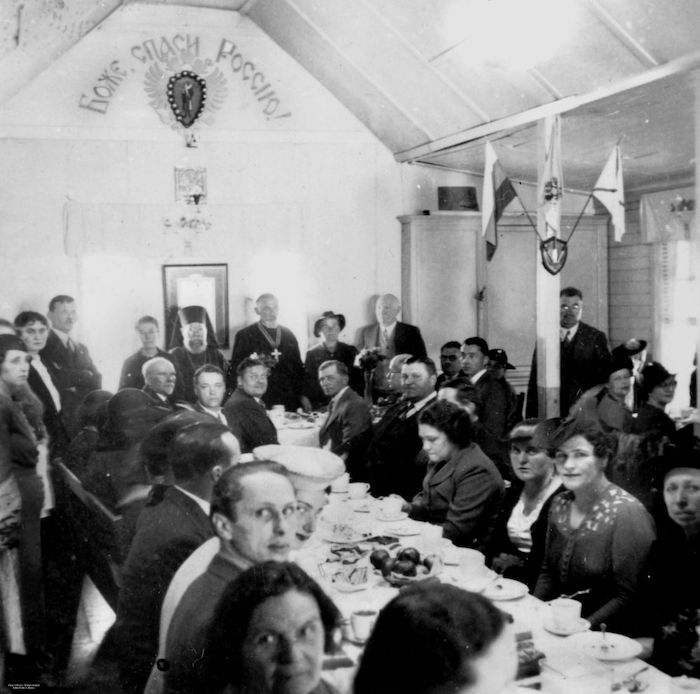

The Russian ballet company, Ballet Russes, was formed in Paris in 1909 by Serge Diaghilev, a prominent impresario and promoter of the arts who revitalised balled by integrating other art forms of music, painting and drama with those of dance. His ballet company became world famous and toured Europe and the Americas. Diaghilev became famous for producing three now well-known Stravinsky masterpieces The Firebird (1910), Petrushka(1911) and The Rite of Spring (1913).

In 193, two years after Diaghilev’s death, two impresarios Colonel W. de Basil and René Blum formed the Ballets Russes de Monte Carlo. They continued the Diaghilev tradition using some of his dancers and performing large parts of his repertoire. During the 1930s and 1940s several Ballet Russes companies toured Europe, the Americas and Australasia. Three companies were formed specifically to tour Australia and New Zealand between 1936 and 1940. All were run by J.C. Williamson Theatres Ltd. Before then Australian audiences had seen some of Diaghilev’s ballets which focused on particular ballerinas, notably Anna Pavlova.
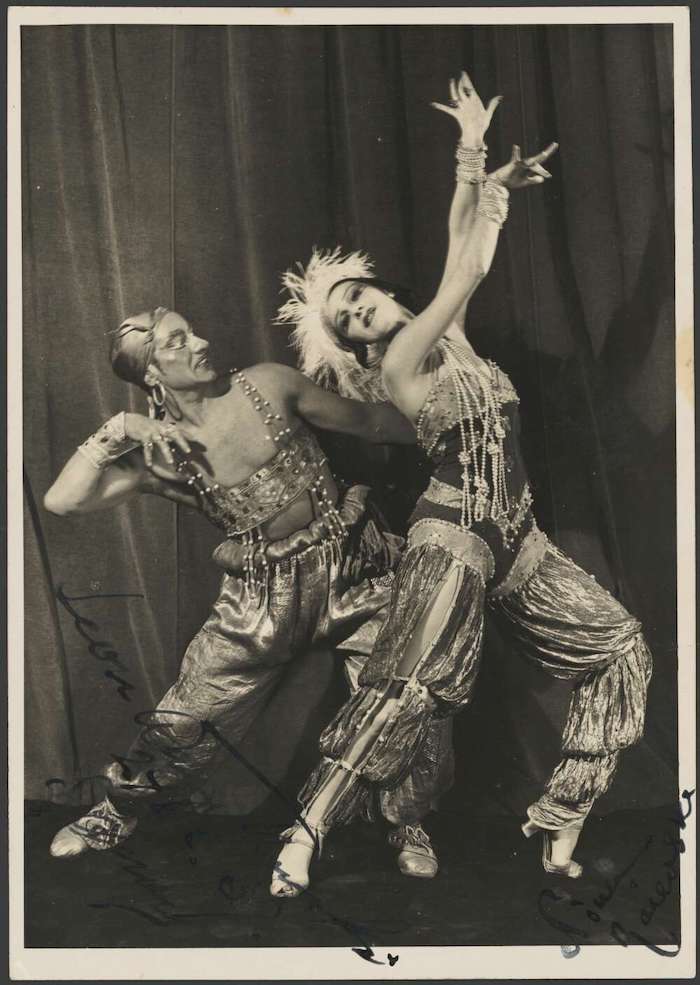
Among the stars of these tours were lead dancers Leon Woizikowsky, Valentina Blinova and Hélène Kirsova.

They are shown in the photos below in some of the roles of performances of Scheherazade, Le Mariage d’Aurora and Les Sylphides which were seen in Brisbane and other Australian cities.
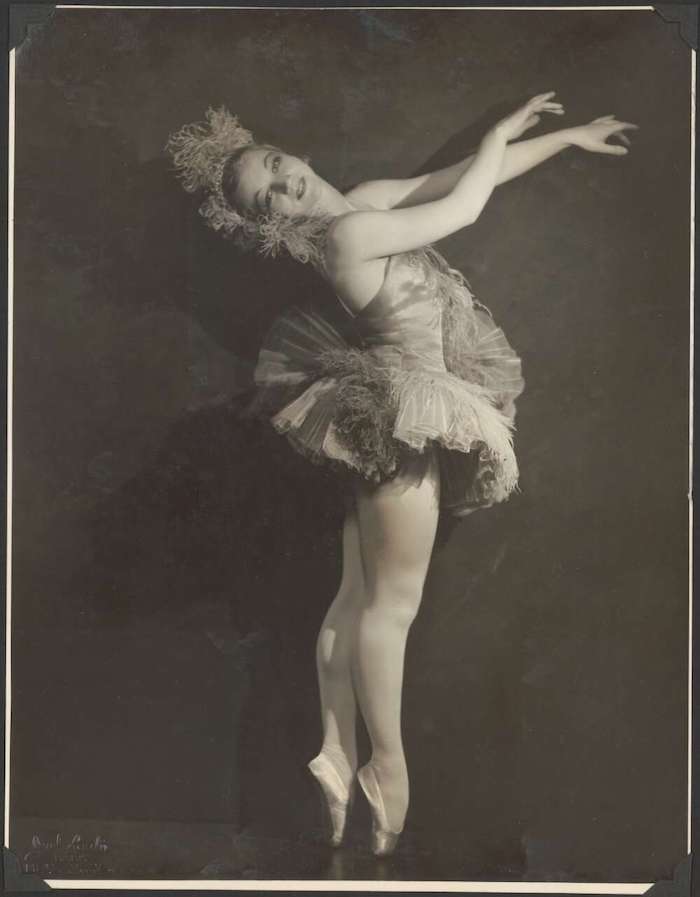

For more information on the Ballet Russes go to https://www.britannica.com/art/ballet/The-era-of-the-Ballets-Russes
(Source: britannica.com/State Library of Queensland/Wikipedia/ National Library of Australia)
Centenary celebrations for St Nicholas
The weekend of 29 May 2023 marks 100 years since the foundation of St Nicholas Russian Orthodox Cathedral. It was established in 1923 by white Russians fleeing the Russian revolution and was the first Russian Orthodox parish in Australia.
The article in the Sunday Mail gives a comprehensive look into the fascinating history of this resilient community.

Seventh Day Adventist Church, O’Keefe Street
This suburb of Woolloongabba played a significant part in the history of the Seventh Day Adventist Church in Brisbane. It was the location of the church’s first Queensland Camp and the first church.
The Seventh Day Adventist Church was formally formed in Brisbane in 1898 and, like most church communities in the early days of the colony, members met in private homes. The South Brisbane group had about 30 members at the time.

Before churches were built the main means of spreading the message was by large camp meetings. The first camp in Queensland was held in 1898 in Logan Road, Woolloongabba from 13-21 October. It was a huge event with about 100 members camped and meetings attracted between 1000-3000 people [see news article excerpt]. A camp highlight was when the main speaker, Sister White, presented her vision for the church in South Brisbane and initiated a drive for a church to be built to promote the growth of the religious message and facilitate its administration. She supported her appeal with a donation of 100 pounds towards a ‘humble church, furnished and painted on the outside and to be finished later on the inside’ on land which had already been bought.

It took only five months for the dream to become reality. On 18 March 1899 the small wooden building [see photo] located in what was then Church Street, Buranda was the very first Brisbane church built for the Adventists. It was dedicated on 18 March 1899 with seventy members and was known as the South Brisbane Seventh Day Adventist Church.

In 1914 a small church school was built at the back of the church with 20 students. A year later the congregation bought a building opposite the church for the school, but this had to be closed in 1926 due to an increase in costs and government regulations.
The church grew and became a well-organised provider of many important religious and community services and activities such as prayer meetings, baptisms, Sabbath School for all ages, annual camps, radio programs, social events and youth and library services.
At the time of the Golden Jubilee church membership had grown to 150 and the 1950s saw many new members from a variety of ethnic and cultural backgrounds. The increasing congregation put extra pressure on the small church, resulting in the decision in May 1960 to build a larger church. Land was bought at 34 O’Keefe Street; Woolloongabba and the old church was sold for £3,400 at the end of the year. A Baptist church on the site was removed to Carindale where it is now a Brethren Church.
The fundraising and building program began with a church hall which was first used on 29 April 1961 when membership was 180. The new church was dedicated on 9 June 1963.
The church continued to flourish, by 1984 there were 381 members. Communication activities, especially in radio, TV, film and recording were extended as well as various community and welfare services. In the 1990s the church buildings were refurbished and the establishment of more churches in nearby suburbs was supported.

The church has kept up with and met the challenges of changing times and needs of the members and local communities in the 21st century.
2019 marked 120 years of the South Brisbane Adventist Church – a time for the church to celebrate its proud history and achievements and continue to build on and expand its significant contribution to local religious and community life.(source: SLQ/Adventist archives and website/Trove)


